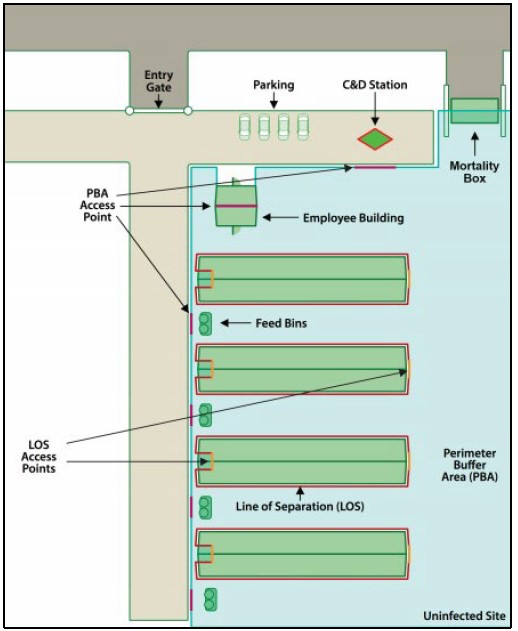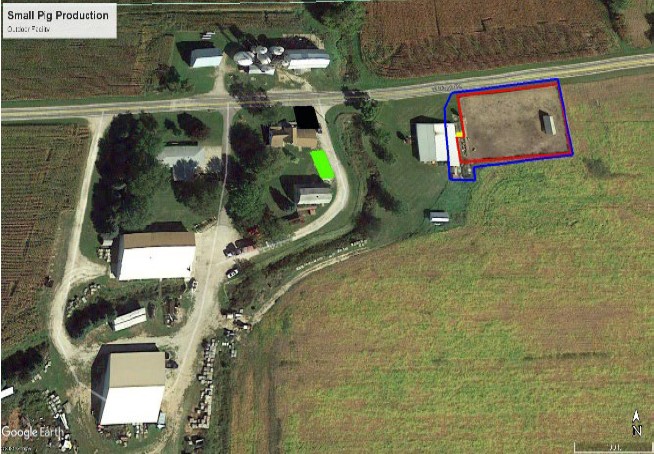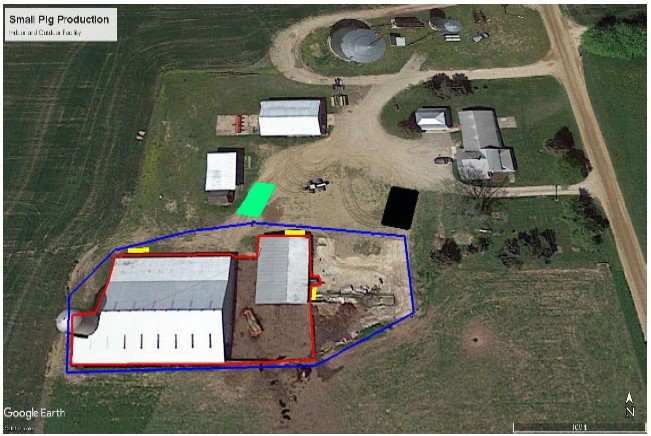
Management over Medication: Biosecurity Plans for Small Farms
DOWNLOADFebruary 14, 2022 - Casey Zangaro, Madonna Benjamin, Michigan State University Extension
MANAGEMENT OVER MEDICATION:
Biosecurity Plans for Small Farms
Maintaining the health of your swine herd requires a biosecurity plan that describes the practical measures you have taken to prevent the entry and spread of diseases on your farm.
Authors
- Casey Zangaro, Swine Production Educator, MSU Extension
phone: 785‑285‑2127, email: zangaroc@msu.edu - Madonna Benjamin, DVM, MS, Assistant Professor, Swine Extension Veterinarian, Large Animal Clinical Sciences, MSU Extension
phone: 517‑614-8875, email: gemus@msu.edu
Produced for MSU Extension (www.extension.msu.edu) by the MSU Extension Educational Materials Team.
MSU is an affirmative-action, equal-opportunity employer, committed to achieving excellence through a diverse workforce and inclusive culture that encourages all people to reach their full potential. Michigan State University Extension programs and materials are open to all without regard to race, color, national origin, gender, gender identity, religion, age, height, weight, disability, political beliefs, sexual orientation, marital status, family status or veteran status. Issued in furtherance of MSU Extension work, acts of May 8 and June 30, 1914, in cooperation with the U.S. Department of Agriculture. Quentin Tyler, Interim Director, MSU Extension, East Lansing, MI 48824. This information is for educational purposes only. Reference to commercial products or trade names does not imply endorsement by MSU Extension or bias against those not mentioned. The 4-H name and emblem have special protections from Congress, protected by Title 18 USC 707. 1P-Web-02/2022-PA/CZ WCAG 2.0 AA
The Biosecurity Plan
Why should you have a biosecurity plan for your farm?
Protecting your swine farm from the entry and spread of diseases is critical. From the farm to the transporter to the processing facilities, everyone plays a role in protecting individual farms and the swine industry from disease outbreaks. This information sheet explains some key practices farm managers can implement to best manage the risk of disease entry and spread on their farms. This is especially important for preventing outbreaks, such as infection by highly pathogenic viruses such as porcine reproductive and respiratory syndrome (PRRSv) and porcine epidemic diarrhea (PEDv) or contagious bacterial infections such as Actinobacillus pleuropneumoniae (APP). Also, in the event of a foreign animal disease (FAD) outbreak, farmers may be required to have a veterinarian-approved enhanced biosecurity plan in place to move pigs to market, customers, or events.
What is a biosecurity plan?
A biosecurity plan is a written document that describes the type of farm operation and protocols in place to reduce spread of disease.
Producer questions to answer when thinking about a biosecurity plan:
- Does your farm have a Premise ID Number (PIN)?
- Do you have a written biosecurity plan for your farm?
- If yes, has the plan been reviewed and signed by a livestock veterinarian?
- Would you be able to confirm that the plan is being fully implemented?
- Does your farm have a biosecurity manager?
What is a biosecurity manager?
You must identify a biosecurity manager for your farm; some states are requiring identification of a back-up biosecurity manager as well. This individual (you, a family member, an employee or business partner) is responsible for developing the biosecurity plan with the assistance of the herd veterinarian (if the biosecurity manager is not a veterinarian). The biosecurity manager is also responsible for ensuring that biosecurity training takes place. This person communicates biosecurity measures with all individuals who provide animal care as well as others who enter the site.
I live in a remote area and keep a closed herd. Why do I need a biosecurity plan?
Biosecurity measures reduce the spread of disease from entering your site and can help control the spread of disease throughout your farming operation. If your operation takes pigs to a processor or an auction barn, or if you pick up supplies from a vendor used by other farmers, a biosecurity plan reduces the risk of bringing infections back to your farm. In addition, in the event of a FAD outbreak, maintaining biosecurity will become an even more critical aspect of your farm operation. Documentation of any movement of animals and people, equipment, and feed onto or off your farm should be readily accessible.
What are some simple biosecurity procedures I can implement on my small farm?
Many diseases move from farm to farm from contact with infected surfaces, which is why including the following simple measures in your biosecurity plan is important.
Examples of biosecurity procedures:
- Wash hands with warm water and soap for 30 seconds before entering or exiting your barn.
- Maintain a separate set of clean clothing and boots to wear in the barn.
- Maintain a log of persons coming in and out of barns containing animals.
- Work the healthiest and youngest pigs first and then work sick pigs at the end of the day.
- Work the youngest to oldest sets of pigs.
- Have at least 48 to 72 hours “down time” before going to another farm that has pigs or going back to your own farm. Make sure anyone entering your barn follows this practice.
- Clean and disinfect your barn and in-barn office on a regular basis.
- Rotate disinfectants on a regular basis.
- Maintain routine pest control, and check bates and traps consistently; don’t rely on a barn cat.
- Post signs to reduce and restrict access to farm and livestock buildings.
- Restrict access to your facility by having a gate or chain at the entrance of livestock and farm areas.
Understanding Biosecurity Principles
The goal of a biosecurity plan is to keep disease from entering the farm by providing protective barriers. The perimeter buffer area (PBA) restricts who or what enters the farm premises. Points of access are entry and exit points into the PBA or across the line of separation (LOS) for entry of essential people or pigs into barns (or pens if animals are raised outside).
Perimeter Buffer Area
The perimeter buffer area (PBA) is the first line of defense against disease entry. It is limited by an outer control boundary and forms the area where animals are housed. The PBA should clearly establish a separation of farm operations unrelated to the daily care of animals. Facilities and equipment important to the function of raising pigs, such as the livestock barns, feed bins, mortality areas, and manure storage areas should be within the PBA. Visitor vehicles and nonessential equipment (propane, trash, and delivery vehicles) should remain outside the barns or pig areas. When visitors or service personnel enter the PBA, they should wear separate and clean cover wear, such as disposable booties and overalls.
Before crossing the PBA, feed and pig delivery vehicles should be clean and, ideally, have disinfected tires and wheel wells. Preferably, vehicles will be washed prior to arriving at the farm. Using a coin-operated car wash is ideal for washing the vehicle prior to arrival. Having separate farm-only vehicles helps with biosecurity by reducing movement of disease-contaminated material (manure, feed, dirt) that collects on tires, floorboards, or doors while being used off your farm.
Line of Separation
The line of separation (LOS) should be clearly marked; this is the hard line between the outside world and the animal area, typically the inside versus the outside of the barn. For pigs raised outside in pens, the LOS will consist of fence and gating (located within the PBA) behind which the pigs are located (see Figure 1).
- Each building (or pen if pigs are raised outside) should have defined entries. The LOS access points are for pigs, people, or equipment entering or exiting the barn or outdoor pen.
- Arriving pigs should be free of infectious disease and livestock transporters should never cross the LOS or enter the barn or outdoor pen space.
- Another LOS access point should be established for people and equipment.
- All farm personnel, visitors, and service personnel should wash their hands before entering or exiting across the LOS.
- The LOS can be a barrier, a step-over, a shower, or a line on the floor with the intent to control the entry of people or pigs. For pigs raised outside, the LOS is the fence and gating contained within the PBA.
- Each LOS should have a logbook for people to sign in and state their most recent contact with pigs.

Caption: Figure 1. Secure Pork Supply Enhanced Map: PBA- inside BLUE area; LOS- RED line outline barns; LOS Access Point- ORANGE, usually doors to barn, C&D Station- Cleaning and Disinfecting area
Source: Used with permission from the Iowa State University Center for Food Security and Public Health. From U.S. Pork Industry Guide to the Secure Pork Supply Plan by Secure Pork Supply and the National Pork Board, 2018, p. 5. https://www.securepork.org/Resources/SPS-Booklet-2018.pdf
Healthy Pigs In, Healthy Pigs Out
- Ensure healthy pigs on arrival. Many farmers purchase pigs from an outside source. The first layer of pig protection should be to purchase healthy pigs.
- Nice people and good friends might not be the best source for your pigs. Do you have the kind of relationship where you can ask your vendor about farm health status and if they had been to another farm in the past 2 to 3 days? Scenario: You hear the dog barking and when you investigate, you see your good neighbor unloading pigs into your barn. They meant to call first, but with family obligations, they thought it was more efficient to load all the 4-H orders onto one trailer and drop them off. This can be an uncomfortable situation. If you had a biosecurity plan and shared those expectations with your suppliers and neighbors, you might have avoided this impromptu situation.
What does biosecurity look like on my small farm?
The basic biosecurity plan for a small farm can be simple, but it should also be specific and provide sufficient detail so that someone filling in for you could follow it. As part of the basic biosecurity plan, you should:
- Identify a biosecurity manager (include name and all contact information).
- Provide all staff training in proper biosecurity practices; provide access to Michigan State University (MSU) Extension Standard Operating Procedures (SOPs) when available.
- Source pigs from a single provider or vendor if possible, or source the minimal number possible to reduce the risk of exposure to new strains of viruses, bacteria, and parasites. Practice “all-in/out” if possible. Isolate new animals for at least 2 weeks.
- Clearly define parking areas with posted signage.
- Describe cleaning and disinfection procedures for on-farm equipment in detail and include any safety precautions for use of disinfectants.
- Define PBA and LOS boundaries with access points clearly posted.
- Prepare vehicles and equipment.
- Clean and disinfect non-animal transport regularly.
- Clean and disinfect animal transport regularly, but always immediately following use off the farm.
- Train personnel.
- Keep an up-to-date logbook including in and out times, employee signature, reason for being there for anyone who crosses the LOS.
- Wear separate and clean clothing and boots. This applies to anyone who crosses the LOS.
- When entering or exiting barns that contain animals, change clothes, and wash hands with hot water and soap for 30 seconds.
- Monitor animal movement.
- Quarantine or isolate incoming animals and evaluate for signs of stress or illness.
- Isolate (keep in separate pens) incoming animals from existing animals in herd for 2 or more weeks before co-mingling; co-mingle only if necessary.
- Have a contingency plan for interrupted animal movement (a FAD outbreak could lead to a national stop movement of all pigs).
- During loading and unloading, trucks and drivers should not cross LOS.
- If choosing options for composting, burial (on-farm options), incineration, rendering, landfill (off-farm options), consider distance from animal housing. Anything close to other livestock species or heavily trafficked areas that could be close to housing could be a potential for disease spread.
- Regarding carcass disposal, check pens in a.m. and p.m. for dead animals (pigs or wildlife). Remove dead animals from pen area as soon as they are discovered and dispose of them properly.
- To properly manage manure, remove solid waste from pens every 2 days; use composting if possible.
- Make sure to properly clean and disinfect equipment used to clean manure.
- Consider a designated set of clothes and boots to clean up manure, and don’t wear the same clothes to other farms.
- Do not allow floor spills (outside of pens).
- Don’t include table scraps in feed if they include (or came in contact with) animal products.
- To control pests, keep baits and traps fully functional and placed at the barn perimeter. Do not allow feed spills. Keep the barn perimeter brush free.
- Have an enhanced biosecurity plan ready in the event of a FAD outbreak. Include emergency contacts if you suspect a FAD infection on your farm as well as specific additional precautions you plan to implement as recommended by your farm vet.
Each of the previous elements should be considered when creating your biosecurity plan. For more detailed instructions and suggested best practices for each of these elements, refer to the MSU Extension website: https://www.canr.msu.edu/pork/
Developing an Enhanced Biosecurity Plan
An enhanced biosecurity plan, which may be required to transport and sell pigs during a FAD outbreak in the U.S., might be as simple as including additional restrictions on pig movement and stricter cleaning protocols. Your vet will be aware of current U.S. Department of Agriculture and Michigan Department of Agriculture and Rural Development recommendations and help ensure that the plan for your farm meets state requirements. However, the plan should be written down and reviewed on a regular basis to ensure proper enhanced biosecurity processes are available and ready for implementation on your farm, if needed at some point in the future.
Biosecurity maps (figures 2 and 3) give an idea of where the PBA, LOS, and parking might be located on a farm.

Figure 2. Indoor/outdoor system. Photo credit: Casey Zangaro via Google Earth

Figure 3. Strictly outdoor system. Photo credit: Casey Zangaro via Google Earth
Figures 2 and 3 are examples of biosecurity maps for small farms, both indoor/outdoor (Figure 2) and strictly outdoor (Figure 3) systems.
• Blue: PBA (Perimeter Buffer Area)
• Red: LOS (Line of Separation)
• Yellow: LOS Access Points
• Green: Visitor Parking
• Purple: Employee Parking
Small Farm Biosecurity Resources
Many other resources can further your knowledge of biosecurity for small farms:
- Michigan State University Extension/Pork Team
- Secure Pork Supply Planning: https://www.securepork.org/
- Pork Checkoff: https://www.porkcheckoff.org/
- University of Minnesota Extension: https://extension.umn.edu/swine/small-scale-swine-production
- Pork Gateway: https://porkgateway.org/
Conclusion
Maintaining farm biosecurity is critical to the health of your herd. Ensuring that your biosecurity plan includes a biosecurity manager, a perimeter buffer area, and a well-defined line of separation will help prevent your herd from getting and spreading diseases. It could also benefit your neighbor’s herd and family.
For More Information
You can find out more about biosecurity and development biosecurity plans for farms and agricultural operations by visiting the Management Over Medication page on the MSU Extension website (www.extension.msu.edu) or by contacting the authors.



 Print
Print Email
Email



